Lightship Columbia returns
The lightship Columbia returns to its Columbia River Maritime Museum home after dry dock and major restoration project.

Council of American Maritime Museums meets in Astoria

CRMM was thrilled to host CAMM’s annual meeting in April 2023. Over 80 representatives from maritime museums around the country enjoyed 4 days of presentations, programs and events on a wide variety of topics.


2
CAMM members enjoyed tours of Astoria’s USCGC Elm and Steadfast as well as a helicopter rescue demonstration.
CAMM members enjoyed an optional tour of the historic Astoria Marine Construction Company shipyard. Photo: Connie Silverman
Both the Ford Kern Rooms (shown) and the Barbey Maritime Center served as venues for CAMM presentations. Photo: Connie Silverman
From the Wheelhouse
Restoration and Preservation
Everything we do at CRMM is focused on our mission: to collect, preserve, display and interpret the maritime history, culture and art of the Columbia River, its tributaries and the waters of the North Pacific for the education and enjoyment of the public. This issue focuses on recent major preservation projects of outdoor artifacts: the lightship Columbia, the Large Navigation Buoy that replaced her when she was decommissioned in 1979, and the two obsolete buoys that mark the entrance to the plaza and 17th Street Pier.
Like the historic pilot boat Peacock, which impressively frames the eastern end of our campus, these maritime artifacts are simply too large to display indoors, and also too important to not be seen. In order to fulfill our mission of displaying and interpreting them for the public, we accept the fact that outdoor vessels are in a constant state of slow deterioration due to exposure to the elements.

We are indebted to the many members and other donors, and grant making agencies, whose generosity and philanthropy made possible not only these preservation projects, but the acquisition of our two Maritime Heritage Resource Center warehouses, where the vast majority of our collections are safely stored indoors. While a number of the important wooden vessels stored inside need substantial restoration work, that work can be deferred as long as the boats are protected from further deterioration.
We are working toward plans to eventually be able to display more of our large vessels, and also to be able to safely bring visitors into collections storage during special events. Look for more information about those opportunities in future issues of The Quarterdeck. In the meantime, do stop by to visit the restored Columbia, and thank you for your continued support!
Columbia River Maritime Museum
Executive Leadership
Sam Johnson
Executive Director
Bruce Jones

Deputy Director Controller
Connie Silverman Controller
Curatorial Operations
Jeff Smith
Curator
Matthew Palmgren Assistant Curator
Meg Glazier-Anderson Registrar
Marcy Dunning
Librarian
Education
Katy Menne
Education Director
Kelly McKenzie Field Educator
Suzi Regan Volunteer Coordinator
Julia Triezenberg
Education Supervisor
Eli Schenk
Museum Educator
Olive Delsol Boat Educator
Facilities Operations
Mike Bruhn
Facilities Manager
Aaron Stinnett Technician
Patric Valade Technician
Toby Dyal Technician
Bruce Jones, Deputy Director
Joe Bob Carter Technician
Membership & Marketing
Caroline Wuebben Manager
Store and Visitor Services
Blue Anderson Visitor Services and Store Manager
Ann Bronson
Associate Store Manager
Helen Honl
Associate Visitor Services Manager
Anna Moltzan
Sales & Visitor Services
Pajo Brooks
Sales & Visitor Services
Muriel Jenson
Sales & Visitor Services
Brittany Pellerin Visitor Services
John Curtin Visitor Services
Paula Bue Visitor Services
Administrative Services
Laurel Fleet Administrative Assistant
Barbey Maritime Center
Chuck Bollong
Instructor & Collections Technician/Researcher
3
Our mission is to collect, preserve, display and interpret the maritime history, culture and art of the Columbia River.
MSC Katie, 1200 feet long and 159 feet wide, passing the Port of Astoria enroute to the Port of Portland on April 5, 2023. The 12,400 TEU container ship is the largest container ship to ever transit the Columbia River. Her bridge is placed well forward to provide adequate visibility over the container stacks.
Restoration of the CRMM Entrance Buoys

Restoration a gift from an anonymous donor
The two “7-18” (7 feet wide and 18 feet tall) buoys are back in place marking the entrance to the plaza and 17th Street Pier after a complete restoration at WCT Marine’s Tongue Point shipyard. The buoys were disassembled, blasted, repaired where necessary, primed, painted and reassembled. The black and red buoy is all riveted construction, indicative of an early 20th century manufacturing date. The red buoy is believed to date from the 1940s. The restoration was funded by a generous gift from an anonymous donor.


4
The upper lighting fixtures and bronze bell were restored. Solar powered LED lighting replaced the older works.
The red buoy with its tower and hatches removed. Work was done inside one of the former US Navy seaplane hangars at Tongue Point.

5
Each buoy weighed over 7,000 pounds and was removed and replaced using equipment and manpower from both Astoria’s Bergerson Construction and WCT Marine and Construction.
The Lightship Columbia restoration project

Several modifications were made during the vessel’s 2021-22 shipyard period
The Lightship Columbia provides our guests a unique experience that can’t be replicated in our galleries on land. There is nothing like descending the ladders and walking the decks of this ship, and imagining life aboard for the small crew during heavy seas, with the diesel generators and main propulsion filling the ship with noise and fumes as waves battered the hull. We are thrilled to have Columbia back in place, and wish to express our gratitude to Diversified Marine, Inc project manager Eric Hunter for his “above and beyond” dedication, and to the talented workers of Portland’s DMI as well as Astoria’s WCT Marine, Inc and Columbia Steel.
For funding, we are also indebted to the National Park Service (Save America’s Treasures grant); M. J. Murdock Charitable Trust; State of Oregon (Cultural Resource Economic Fund and Cultural Advocacy Coalition); and the very many private individuals who gave so generously to this project.
Finally, we are grateful for the wise counsel and hard work of retired marine engineer and Volunteer Lightship Maintenance Coordinator Doug Taylor (see Doug’s article on following pages).
The lightship Columbia is a unique experience. There is nothing like descending the ladders and walking the decks of this ship, and imagining life aboard for the small crew during heavy seas.
6
Easing Columbia out of her berth between a river cruise ship and the shoreline at night in order to arrive at drydock in Portland at daybreak.
Restoring the Lightship Columbia

The Lightship Columbia, built by the Rice Brothers Corp. of Maine in 1950, was retired from service in 1979. She has been moored as a tourist attraction on the Astoria waterfront for the past 43 years. Countless visitors have walked its decks and learned about its mission as an invaluable aid to navigation. The Columbia was the last and most advanced of several lightships to be anchored at a fixed location approximately 5 miles offshore of the treacherous Columbia River bar.
For many years after its retirement, the Lightship engine rooms, and topside machinery were maintained in an operating condition. The ship was periodically sailed up and down the river by volunteers and past crew members. As she aged, however, a decision was taken to change the ship’s status from active, to one of being permanently moored. Since that time, the below decks engine rooms have been monitored, but have not been maintained or made available to museum visitors. This was about to change.
During Columbia’s 2021-22 shipyard period, several modifications were made to the vessel with the vision of having visitors, once again, being able to safely descend into the engine rooms and view the unique and cutting edge 1950’s marine equipment. That equipment, by the way, is very rare and is a piece of America’s maritime history.
As an Astoria resident and new volunteer, I toured the vessel not long after its return to Astoria last spring (after the completion of the drydock at Diversified Marine in Portland) to understand the museum leadership’s vision of cleaning up and restoring the engine rooms. I remember looking around the 2 engine rooms and being transported back to the early years of my career sailing on old tugboats of that same post WW2 era. But I had trouble seeing through the years of dust and grime to envision what might be possible. Nonetheless, it was clear to me that the restoration and cleanup of the machinery spaces was possible if the ship was still in good condition.

7
Photos from top: Columbia’s old paint is removed. 200 ultrasound tests were done of the ship’s hull, and it was found to be in excellent condition. Columbia received her first coat of epoxy primer in drydock at Diversified Marine, Inc. Photo: Kurt Redd
Story by Doug Taylor, Volunteer Lightship Maintenance Coordinator and retired marine engineer
There were many hours after my docent shifts were over, where I had opportunity to wander the internal spaces of the ship alone. I learned about the systems and equipment, and lifted deck plates and measured ballast storage tank levels to satisfy myself that the ship still had good bones. And there were hours of research in the museum archives and on the internet, to learn about the original outfitting, equipment, and maintenance history. I read all the log entries I could find, and absorbed all the vessel’s drydocking files that were tucked away in the archives. And strangely, as I dug in more, I became connected to the ship and surprisingly, found myself excited to go aboard. Being retired, my wife and most of my friends tried to talk sense into me, but true to form, I had already agreed with Bruce Jones that I would undertake the project and complete it by the end of March 2023.
The original design of the Columbia’s engine rooms provided redundancy of most ship systems and the electrical supply. Should something go wrong in one engine room (flooding or fire), the onboard engineer could route some critical systems and electrical power from the functioning engine room to keep the ship going. A heavy watertight bulkhead between the two engine rooms was originally installed to isolate them from each other. The crew would enter and exit each engine room separately via ladders and emergency escape ways but couldn’t move directly between engine rooms. During the recent shipyard period, however, a passageway was created in that watertight bulkhead allowing visitors to enter one engine room and exit out the other. This was a huge benefit for the restoration team, as we moved forward and back between engine rooms hundreds of times.

The restoration project was broken into several smaller tasks, starting with some maintenance of the ship’s electrical system and piping insulation. Next came the tedious cleaning and hand painting of nearly all equipment and structure, starting with the forward engine room. One of the challenges we had was finding enough manpower to complete the task. CRMM Facilities staff Gary, Mike, Pat, Joe Bob and Aaron, having years of experience with the ship, were instrumental throughout the project, as we dealt with heavy electrical panels, steel doors, supplies and other heavy equipment. Volunteer Lloyd Bowler was a stalwart through the second half of the restoration, nimbly cleaning and painting in virtually any position and location. My nephew Mitch even came down from Portland and spent days with me cleaning and painting the forward engine room. He became an expert with my airless painter, which we used liberally throughout the project.
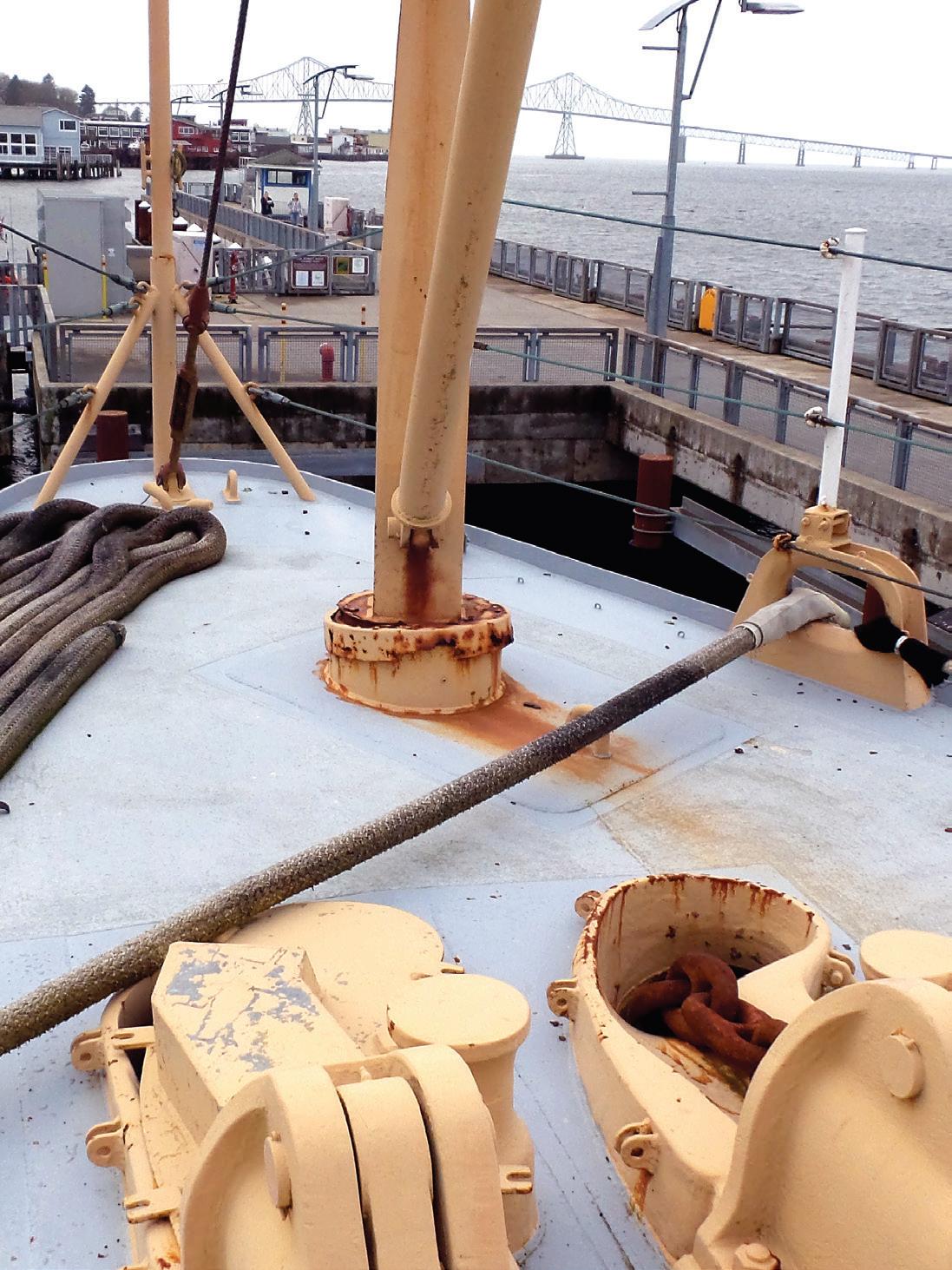
8
Photos at left: Severely deteriorated metal such as the collar on this crane was replaced, while the rest was blasted, primed and painted. The entire deck was blasted, primed, and coated with nonskid coating.
The discovery during blasting that Columbia’s entire wheelhouse is naval brass (to reduce magnetic deviation of the compass) came as a surprise to all. The wheelhouse had always been painted white. This led to interesting discussions with DMI’s lightship project manager, Eric Hunter (facing camera) about whether or not to leave the brass exposed. With no volunteers to keep the brass polished, we decided to return all except one door to the original white. The exposed brass door gives visitors a sense of what is underneath the rest of the house.
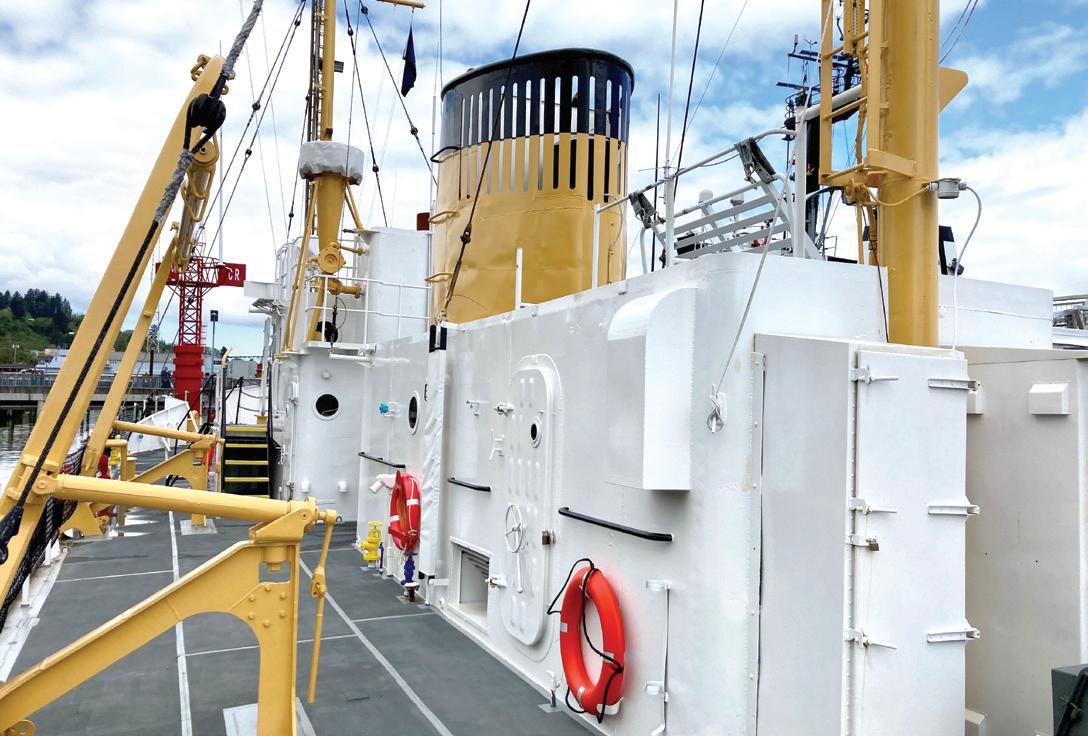

Pre-drydock, the only way for CRMM staff to access the bow was climbing over the bow splash. In order to provide access for visitors and staff, a section of the bow splash was removed, hinged, and converted into a door that can be easily opened and closed.




9
Superstructure after metal repairs and painting.
Finding the correct paints in the correct color was a big challenge. The original gloss white engine rooms and system piping had yellowed over the years and didn’t match any color swatch we could find. And it was clear that to be cost effective and safe, in such confined spaces, we would only be using water-based paints on most surfaces. This was easier said than done. At the outset, we would brush or spray a surface only to come back in the morning to find that the paint didn’t adhere, or that the base color or residue had leached through and effectively ruined the paint. Thankfully, after many attempts and discussions with paint specialists, we found an outdoor household paint that worked perfectly. And it was available locally and not overly expensive. As we prepared for painting, we didn’t want to do too much cleaning or use nasty solvents and large quantities of water. We simply didn’t have a realistic way of getting hazardous liquids or water out of the bilges, as all original bilge pumping equipment had been intentionally decommissioned. We also wanted to minimize our exposure to fumes and hazardous materials. This left us using hand squirt bottles, safe degreasers, rags and elbow grease to clean every inch of those two engine rooms. Lastly, since none of us wanted to do all the cleaning at once, we opted to clean a little, and paint a little. Seeing some new paint every week helped keep us going.
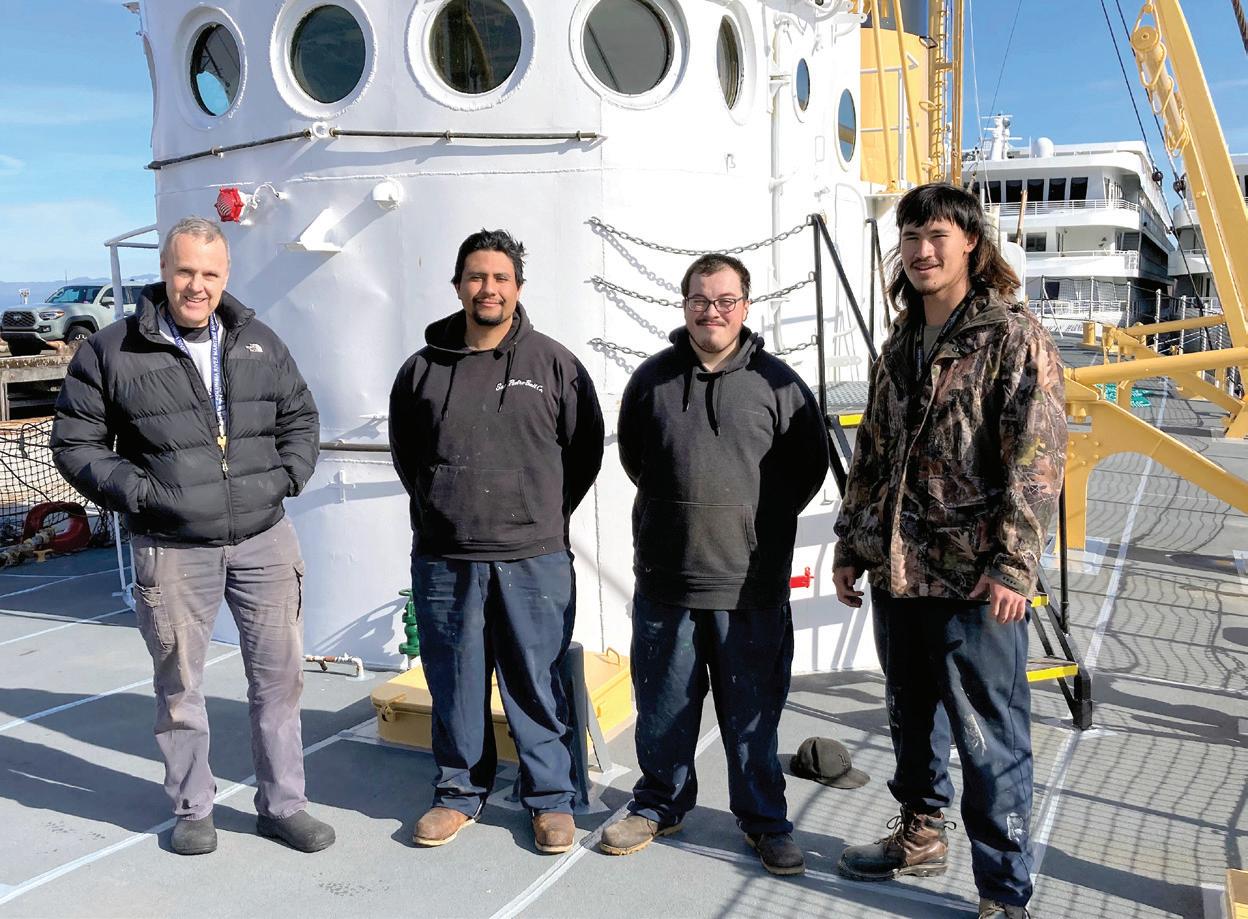


10
A secondary goal of the restoration and preservation project was to open as many areas of the ship as possible to the public. Previously closed areas that are still difficult or unsafe for visitors to enter, such as the Bosun’s Locker and Aft Steering (shown here), have had Plexiglas and interior lighting installed to allow visual access.
Volunteer Columbia Maintenance Coordinator Doug Taylor with Tongue Point Job Corps Seamanship students Eduardo Zanelli, Oliver Zapata, and Kahoa Wilson. Not shown: Lucille Middour.
Photos from top: The new gangway utilizes a tower system hinged at either end and easily accommodates the full range of tidal conditions; The pre-restoration gangway was unsafe to board during high tides and stormy weather. As a result, Columbia was frequently closed, especially in winter.
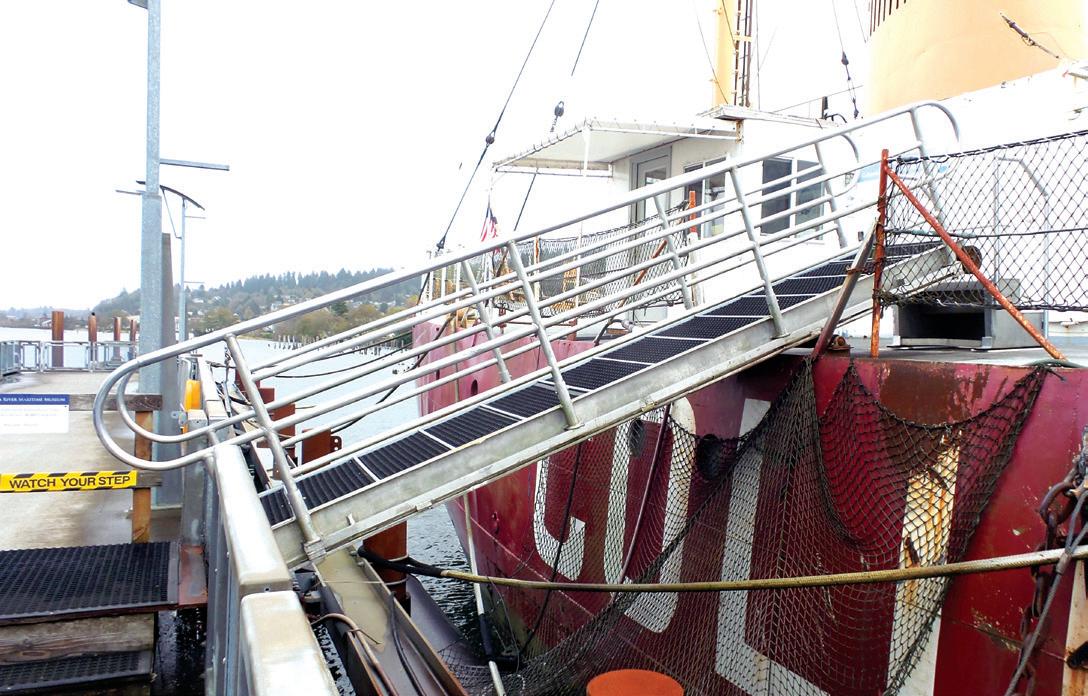

The real heroes of this restoration were the folks from our local Tongue Point Job Corp Center Seamanship Program. Four cadets were made available to help us through a Work Based Learning agreement. Ed, Kaoha, Lucille and Oliver worked three days a week for 5 or 6 hour shifts. They sat through my practical training on key engineering disciplines for roughly half of the shift, and had a paint sprayer, scraper, rag and degreaser or paint brush in their hands for the other half. Some training seemed like a good tradeoff for their hard work. It was a rewarding experience for me, to say the least, as we explored all manner of “old” equipment on the Columbia; similar in function and construction to modern maritime equipment, but without any digital controls, and complex automation or monitoring features. Sort of like someone from SpaceX looking at the 1960’s Apollo Saturn V rocket.

11
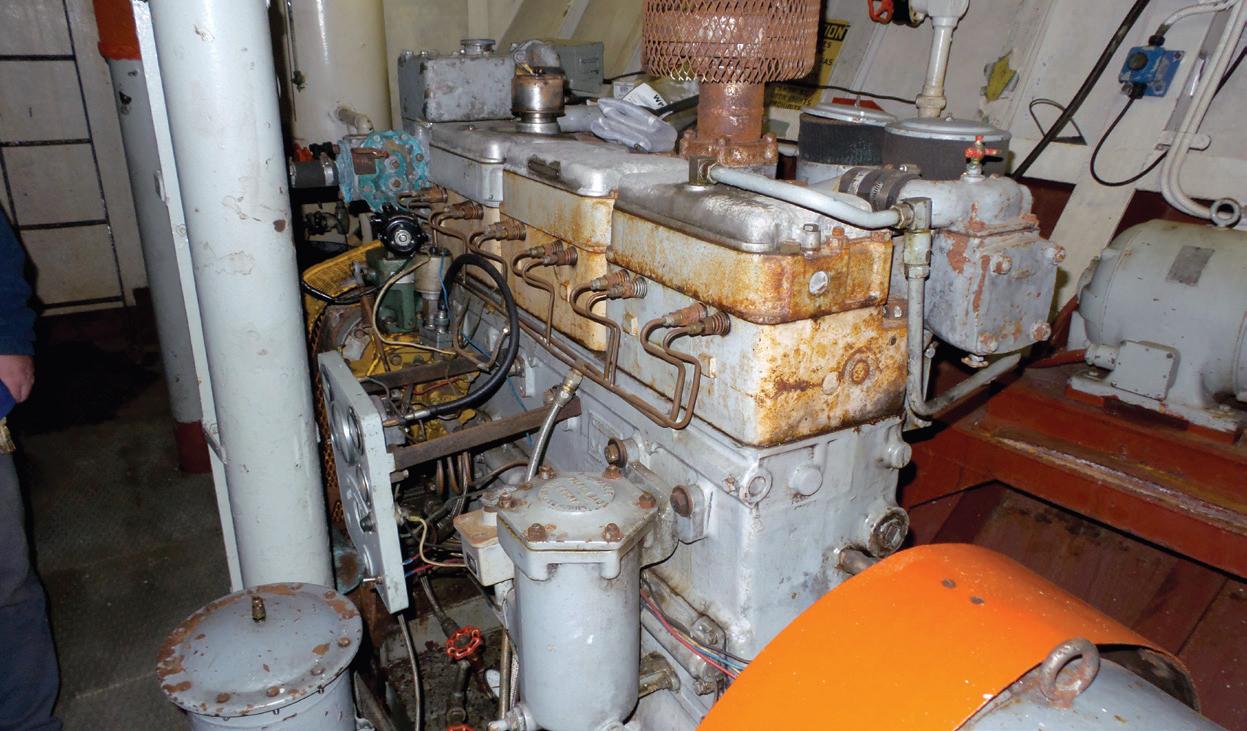



12
Photos clockwise from top left: The main propulsion engine before the restoration project; One of the Cummins diesel generators used to generate shipboard electrical power before and after restoration; The main propulsion engine after the restoration project.
The Cummins diesel engines used on the generators, for example, were all manually operated and had only the most basic alarms and instrumentation. Yet at the time, that model of engine, coupled with General Electric alternating current (AC) generators, (the first class of lightship to have AC instead of direct current (DC) power or no electrical power), were of the highest quality. Those engines remain some of the finest examples of old Cummins engines anywhere. And the same goes for Columbia’s propulsion engine. The late model, 550 horsepower Atlas Imperial Diesel Engine is of the same make as the much older big green engine you see as you enter the Museum. Atlas improved its engines over time, and Columbia’s engine included a cutting-edge turbocharger (one of the early models used on marine engines), more advanced fuel pumps, fuel injectors, and auxiliary equipment. But like all Atlas engines, it was still a 4-stroke direct reversible. What that means is that unlike modern diesel engines of its size, this engine could be operated in both clockwise and counterclockwise rotations. For example, when the wheelhouse sent a maneuvering command via the mechanical engine order telegraph to the engine room, the engineer, perched under the access ladder in the aft engine room, would operate the engine’s control lever to go from ahead to astern. If operating in the clockwise rotation (ahead), the engineer would shut down the engine, use the controls to slide the camshaft, and restart the engine in the counterclockwise rotation. This would propel the ship astern, similarly to how that maneuver is accomplished on modern big ships.
Now the preliminary restoration of the engine rooms is complete, but there are many other interesting and remarkable things to see and experience on Columbia. I want to thank Bruce and the Museum leadership team for their unwavering support of this project. Please come down to see Columbia for yourself. She’s awesome!

Contact
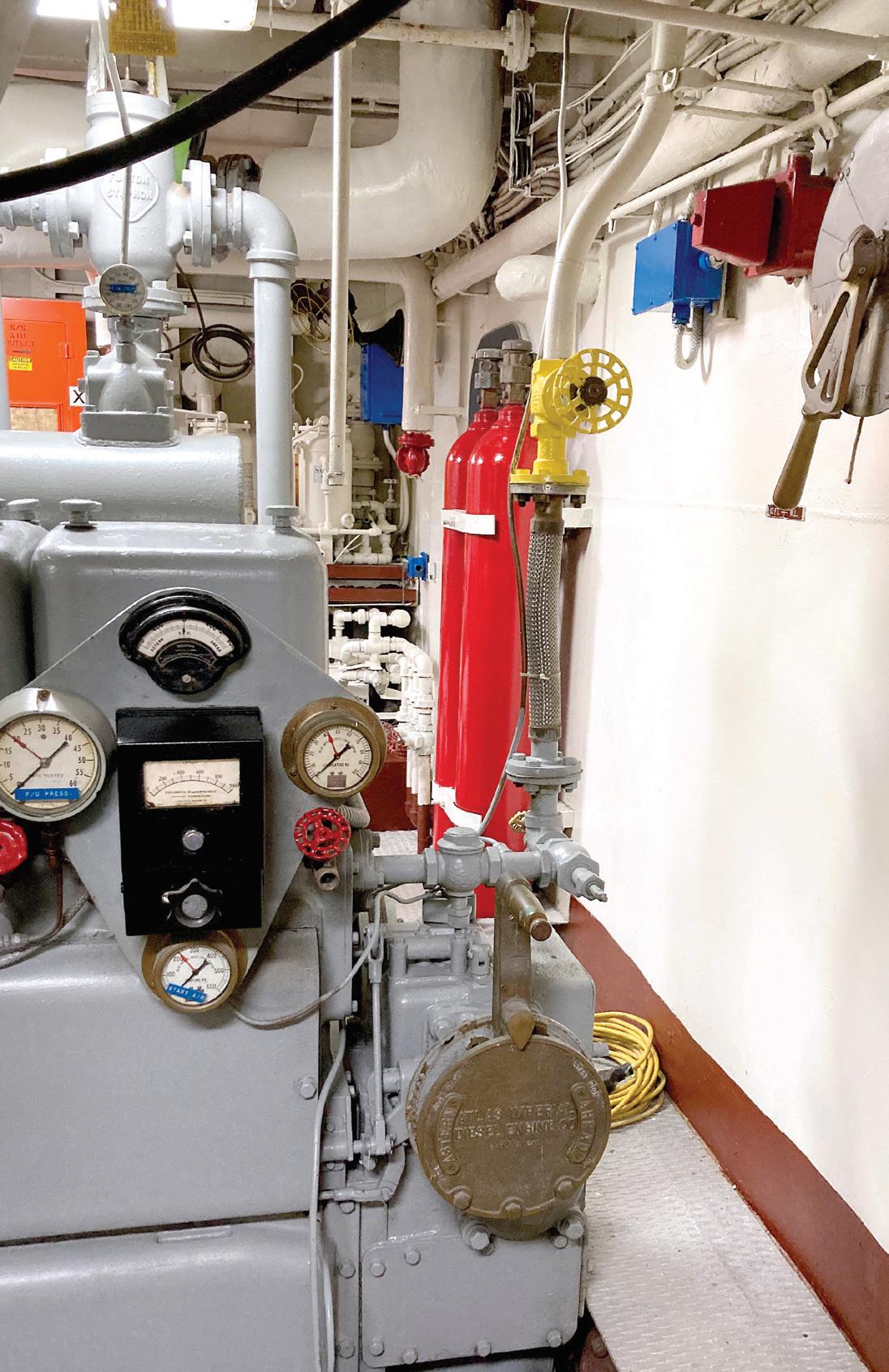
13
In addition showing off the benefits of cleaning and painting, this “after” photo shows the remarkable improvement in lighting provided by the installation of LED lights inside over 75 original fixtures below decks.
Interested in helping us give engine room tours?
Suzi Regan: volunteer@crmm.org to learn about becoming a Columbia docent.
Large Navigation Buoy Restoration
Columbia River LNB returns with lightship Columbia

In the mid-1960s, the Coast Guard began work on development of a Large Navigation Buoy (LNB), or “monster buoy”, in order to reduce the number of manned lightships anchored in shipping lanes. 40 feet tall and 40 feet wide, the buoy had a hull large enough for personnel to stand inside easily. Its power system furnished electrical power for audio, visual and radio beacons as well as oceanographic and meteorological equipment which transmitted data to a shore station.
Ten unmanned Large Navigation Buoys (LNB) were constructed by General Dynamics, including the Columbia River LNB , which replaced the lightship Columbia in 1979.
After little more than a decade in service, LNBs were eclipsed by new technologies which allowed smaller buoys with all the capabilities of the LNB.
The CR LNB was removed from its position next to the lightship when the new 17th Street Pier was built over a decade ago. The buoy was stored at Tongue Point until the lightship restoration project fundraising allowed the LNB to be restored and returned to the water, where it attracts a great deal of attention, and is the only LNB we are aware of that has been restored and displayed for the public.
14
WCT Marine towboats and crane barge return the LNB and lightship to the 17th Street Pier.




15
Separate watertight compartments inside the LNB contain all the original equipment in pristine condition
Exterior deck of LNB prior to restoration.
The heavily deteriorated rubber bumpers were removed from the LNB.
Curator Jeff Smith examines one of the original headsets left behind when the Coast Guard donated the LNB to the Museum.




16
LNB tower after blasting and painting.
The LNB tower had to be removed in order for the LNB to fit inside the seaplane hangar.
Reattaching the tower to the LNB hull.
The LNB in the hanger prior to restoration.
17 In Honor Of August 1, 2022 - April 30, 2023 Memorials August 1, 2022 – April 30, 2023 Anita Barbey & Todd Liebow Cindy Gentry Joe & Gwynn Bakkensen Patrick & Molly Kearney Leney Barclay Crew of the USS Knapp DD-653 Peter Brix Stephen & Anne Andersen Joan Bailey Mary C. (Chita) Becker Mort & Mary Lang Bishop Tim & Mary Boyle Stewart & Mary Butler Ward & Lois Cook John Crawford & Jody Stahancyk R.J. DeArmond Trust Marietta Doney Alan C. Goudy Jerry & Marilyn Gustafson Ken & Joyce Gustafson Hillary Lacy Hagler Frank & Karen Halvorsen Robert & Janis Harrison Halton Foundation H. Earl and Barbara Hoover Hank & Judith Hummelt Dr. Samuel E. Johnson Samuel S. Johnson Foundation Milton & Helena Lankton Leaverton Family Fund Joanne M. Lilley Ernest & Diane McCall Mary Lou McClung Jerry Ostermiller & Lynne Johnson Larry & Shirley Perkins Donald Rhodes Brian & Bambi Rice Pedro & Ann Rosales L. Pendleton & Nancy Siegel John Stephens Peter Stott Anne Swindells George Swindells Taylor Metal, Inc. Joseph P. Tennant Charitable Fund The Tennant Foundation Thomas & Martha Vandermolen The John & Frances Von Schlegell Family Fund The Vesce Family Lily Vesce Marc & Nancy Sue Wallace Carolyn Brooks Paul & Mary Louise Phillips Orabelle Bruneau Sam & Julie Henzel Theodore (Ted) Bugas Marilyn Birkel The Dulcich Family Molly Edison Patrick & Molly Kearney Janice Leber Larry & Shirley Perkins Della, Earl, Laurie, Naomi & Steve Pollock Barbara Schulman & Ted Giese Dan & Kim Supple Kerry Tymchuk Theodore (Ted) and Pat Bugas Allison Cellars The Law Family Della, Earl, Laurie, Naomi & Steve Pollock Radar Management, LLC Barbara Campbell-Engbretson Patrick O’Grady Norman D. Davis Jr. Edward Edens Tom Dulcich Jeffrey F. Dulcich Clovia Erickson Paul & Mary Louise Phillips Mary Lou Velder & Darlene Velder Story Sue Evans Lydia Hershey Cdr. Richard Gerety Crew of the USS Knapp DD-653 Marilyn Gustafson Ward & Lois Cook Gary & Patricia Deane Skip Hauke Ron and Kim Williams Esther Jerrell Capt. Fred B. Jerrell Estelle Duggan Tony Johnson Bill & Muffy Beeler Phil Kulzcazk Crew of the USS Knapp DD-653 Jeffrey Lampa Cindy Lampa Jack Marincovich Mike & Tami Aho Dorothy Deacon Brad Hosmar Michelle Hosmer Robert Jolma & Rebecca Fisher Bart Oja Larry & Shirley Perkins Paul & Mary Louise Phillips Ed & Joy Stack Dan & Kim Supple John Mattson Teri & Devin Hearing David Myers Strode & Nan Brent Ward & Lois Cook Steve Fick, Fishhawk Fisheries, Inc. Daniel Goldman Alan C. Goudy Don & Carol Haskell Dr. Samuel E. Johnson Milton & Helena Lankton Michael Lower Anne P. Myers Eric Paulson Mike & Marian Soderberg William T.C. & Cornie Stevens John Vaughey Charles Nappi, BM3 Crew of the USS Knapp DD-653 Brian A. Rice George & Patty Beall James & Elizabeth Davis Alan C. Goudy Roger Martin Marcia Walsh Molly Weston Capt James Richards Capt. Jeffrey & Linda Salfen Gene Sause Stewart & Mary Butler Richard Schroeder Rich & Mary Hormaechea Thomas Schwartz Jeff Shepard Todd Olsen Stan Smith, BM3 Crew of the USS Knapp DD-653 June Spence Samuel S. Johnson Foundation Clifford Stephens Nancy Lee Anshutz Dennis Derby Suzanne Harvey Nick & Joan Johnson Lee & Adrienne Peterson Jeanette Slepian Bill Zankl, FC3 Crew of the USS Knapp DD-653
CRMM: New Members August 1, 2022 - April 30, 2023 Boatswain Brady and Keely Pierce Dale and Jackie Jacobson David and Kathi Wilbur Hannah Hill and Perry Bergman Harpreet Singh and Sangeeta Kalsi James and Elizabeth Hunter Jeffrey and Cheryl Maclean Jim Gilbert and Lorraine Gardner Kate Darling and Tim Kennedy Margie and Doug Archer Patricia and John Donbeck Patricia Tolle and Deborah A. Bailey Ryan Brazeau and Sarah Shannon Sharon and Dave Trageser Tamara and Logan Cameron Tambra Thomayer and Marvin Osgood Toshina and Juan Nunez Vincent and Deb Cannella William and Margaret Norton Business Member Arrow Tugboat & Tour Company LLC Sea Nook Cottage Crew Aaron Kazlauskas Adam and Karen Fischer Alexandrea and Jonthan Hoffman Allison McCoy Amanda and Willy Mulder Amy Dachtler Andy and Becky Franklin Andy and Debra Shortman Andy and Molly Hasenkamp Annette Pronk Barbara Ensminger and Mike Walker Becky and Sean Carrell Bill and Katie Barnum Bonnie and Derick Lock Brandon and Sally Loewen Brian and Alisha Silken Brian Bralley and Judy Duff Buck and Brenda Braden Cassandra and Lance Becker Charles Ingalls Chelsea and Andrew Mattingly Chris and Dawn Marley Chris and Suzy Wright Chris Bockes and Blythe Delucia Christina and Ryan Richmond Clark and Heather Ritchie Cliff Self and Danny Freitag Connie Norton and Eric Harmes Conrad and Gretchen Verpoorten Cory and Alison Spangler Courtney Clements and Scott Seeley Crystal Flaigg and Bruce Spencer Dan Rivera Daniel and Ronna Norton Daryl Long and Julie Aiger David and Laura Lains David and Rachel Bjorklund David Beach Derek and Jenessa Oliver Dianne Anderson and Mel Katz Elizabeth and David Turnbull Emily Hackenberg Eric and Hannah Hantho Eric and Kathryn Lederer Eric Hinton and Cathy Wissink Erica and Adam Stuart Felisa Macabeo and Jonathan Long Fred and Ann Pot Gary and Kristi Ward Greg and Joan West Greg and Julie Cox Hillary Hulen and David Ruegg Homer Chin and Xubo Song Indira Ismailova and Oleg Kharitonov Jack Russell Thompson Jack Russell Thompson Jack Russell Thompson Jack Russell Thompson Jack Russell Thompson Jack Russell Thompson Jacob and Riane Enos Jamie Seabold and Julie Shewchuk Janice Leber and David Rubin Jennifer and Andrew Reinhardt Jim and Leslie Gestautas Joe and Andrea Aguiler Joe and Christa Giordano Joe and Monika Garrett John Jr. and Leslie Shepherd Johnette and Todd Longtain Jordan and Cassie Berven Judith Mackey and Laurel Helm Julie Rhoades and Jacki Rice Jun Huang and Lili Cai Justin Studinarz Kate Manship and Betty Telfer Kathleen and Lukas Montion Kelly and Michael Davis Ken Sr. and Mary Copeland Kurtis Muntz and Barbara Ghio Lani Astorga Linda and Chris Haskell Lon and Cindy Rice Luke and Kara Deal Lynn and Dawn Jackson Marci and Gerald Caird Margaret Kennedy Mark and Eve Stover Mark Porter Markus and Yvette Vangen Mathew and Tracy Ferrero Matthew and Melissa Lewis Max and Carol Hegewald Melissa and Benjamin Parritt Meredith Wood and Shane Carter Michael and Jessica DeRoie Michael Cook and Rachel Loziwk Michael Murdoch Mindy Cummings Molly Moran and Terry Hollowell Monica and Ian Adams Monty Ranvick and Mary Anne Champagne Natalie and Corrie Nichol Nathan and Valerie Stoller Nia and Matt Sopiwnik Nicole Maki and Natalie Fulton Nicole Tiffany and Joy Green Noah and Shannon Katka Olen Golden and Tyler Dau-Golden Oscar and Danae Kramer PJ Angelini and Marissa Kourkoumelis Ramsey and McKenna Selbak Randi and Colin Davis Rebecca and Allen Hansen Richard and Carol Forst Richard and Kate Wright Robert and Deborah Sipe Robert and Marilyn Brockey Ron and Laura Larson Ronald Janard Rosamaria and Gregory Rudy and Kafi Carrasce Ryan and Katrina Karvonen Ryan Loftus and M. Kelsey Lane Sally and Tyler Hansell Scott and Angela Spence Scott McLeod Shane and Andrea Brown Shannon and Jason Garcia Sheri and Craig Phares Sheri Lichtenstein McCollom and Andrew McCollom Sherrill J. Hartline Shonn and Crystal Tanner Stephanie Akutsu and Tracy Laxson Stephen and Christina Bartholomew Steve and Katya Stadel Susie and Tim Leslie Tammy Alkire and Timothy Schendel Thomas and Mary Lee Horgan Tim Michalsky Timothy and Betty Conces Timothy and Jodie Nebel Todd and Paula Miller Tom and Megan Atkins Tom and Tricia Rogers Travis and Brenda Fullerton Troy and Brookley Henri Tzu-Hsing Hung and Shan-Chih Chuang Vito and April Pacheco Wally and Rebecca Rogers Wendell and Ruth Martin Wendy Brossard and Sierra Houghton Xinrui Zheng and Ying Li Ensign Adam Palik Adam Smith Darlene Gaetano Dena McNeel Donna Moniz Faith Fields Gerald Carter Gloria Cummins Jack Russell Thompson James B. Stokes Jenni Garr Jennifer Eagar Jennifer Taylor Jerry Jones Jessica MacFarlane John Kohnen KC Matlock Kim Wilson Lauren Davis LinMarie DiCianni Masyn McCulloch Michael Martin Ramonda Vernon Richard Hoage Sallie Vandagrift Sarah Fuge Scott Santaguida Shankar Viswanathan Sharon Kubik Helmsman Aaron and Laura Trimble Alex Doroshhu Andrew and Susan Shanafelt Anna Johnson and Bethany Myers Asbel Sanchez and Sara Gutierrez Aslyn and Kevin Fisher Blake and Alyssa Martz Brad and Arla Ayers Brenda and Jackson Hughston Bryce and Lindsey Paulson Cannon Beach Historical Society Chennel and Michael Evans Christina Freeburg and David Sellers Dan Corcoran Daniel and Alyssa Webb David and Karla Delap Deborah and Randy Hunter Deron Aucoin and Lindsay Stone Devin and Raelyn Rigby Eber Hampton and Vicki Franklin Edwin and Wendy Flick 18
Volunteer Activities at CRMM
CRMM welcomed new Volunteer Coordinator Suzi Regan this Spring, and bade her predecessor Rachael Forden fair winds and following seas. Spring is a time for fresh life to be breathed into all aspects of personal and professional life! The CRMM Volunteer Program offers exactly that, whether it is springtime or not. Our Volunteer Coordinator and Education Supervisor Julia Triezenberg have collaborated on numerous opportunities to excite our dedicated volunteers.
In January, Education Director Katy Menne hosted two informal sessions to share museum updates and brainstorm for future programming. Captain Dan Jordan, Trustee and current Bar Pilot, gave a talk about his work on the Columbia River. He shared about the basics of bar pilots, including how it is decided to bring a ship in or if pilotage is suspended. Pilots play an integral role in the Columbia River’s maritime commerce, and with so many new volunteers it was the perfect time for Captain Jordan to kick off the year with a refresh.
In February, volunteers could attend a CRMM General Orientation, an EDU Cart training, and a tour of the Maritime Heritage Resource Center (MHRC) Boat Hall.
General orientations are offered periodically to all volunteers to learn about the museum’s history, mission, staff, and a variety of ways they can donate their time.
In our CRMM EDU Cart training, volunteers learn all about how to use the cart when interacting with the public. Currently there are two offerings: “Early Fur Trade History” and “Lighthouses of the Pacific Northwest.” Each topic has several touchable items that interest patrons of all ages and abilities. Through informal conversations, visitors can have a more handson experience and more deeply understand content in exhibits or items on display behind glass. The cart has offered volunteers a way to teach without having to give a formal tour or program.
February wrapped up with a tour of the MHRC Boat Hall. Volunteers got to explore the collections warehouse filled with all the vessels not currently on display. Jeff Smith, Curator, was on hand to give background and answer questions on some key vessels in the collection.
March brought the second installment of docent training with a key focus on how people learn as well as incorporating artifacts to tell an overarching story. This Spring also brought orientations on the Warnock Model Boat Pond and the Lightship Columbia. The Education Department is working to better utilize all aspects of the museum campus to share our mission of preserving and interpreting the maritime culture of the Columbia River and its communities.
Finally, in April, volunteers were instrumental in ensuring a successful Council of American Maritime Museums event, greeting and meeting the logistical needs of over 80 guests from around the country.
Are you sold on joining our volunteer crew? There are endless ways you can help!
Please reach out to Volunteer Coordinator Suzi Regan at volunteer@crmm.org for more information.
Betsy Johnson
Captain Dan Jordan
Linda Keizer
Kenneth Kirn
Irene E. Martin
Anne McAlpin
Mary Meyers
David Nygaard
Mike Sarin
Samantha Shaver
William T.C. Stevens
Alex Strogen
Shawn M. Teevin
Sarah Tennant
Dr. Gerald Warnock
Trustee Emeritus
Alan C. Goudy
Donald W. Magnusen
Advisory Trustees
Guy C. Stephenson
Ambassador Charles J. Swindells
Willis Van Dusen
Bill W. Wyatt
In Memory
Peter J. Brix
David M. Myers
The Quarterdeck Summer 2023
The Quarterdeck is published by the Columbia River Maritime Museum 1792 Marine Drive, Astoria, Oregon 97103 503-325-2323 • www.crmm.org
Editor: Bruce Jones
Printed by: Lithtex in Hillsboro, Oregon
Layout/Design: John D. Bruijn, The Astorian
All photos by Bruce Jones unless otherwise noted.
19 Helmsman (continued) Elaine Saunders Harry and Carol Bell Heather Charvet Heidi and Derek Gilliland Jacque and Amanda Swan Jared and Lindsay Schulz Jeff and Erica Hiatt Jeffrey Roost Jeni and Jim Posenjak Jeremy and Jennifer Evans Jim and Andria Montgomery Joanna and Brett Bishop Katelyn Corno and Jason Treese Katie Spring and Jim Berke Katy Shipley Ken and Danielle Treis Kristen Olsen Lavine and Joane Linker Lea and Paul See Leonard Peterson and Ramona Granath Lindsay Matson Marny Musielak and Jeffery Morrill Marti Mattia Melissa and Jared Waldman Michael and Isolde Stodelle Michael and Tina Toth Michael Handorf and Sherie Thomas Michele Kimble and Deanna Hurley Hockema Michelle and Saul Farber Mike Lawson and Elizabeth Garrison Milda Vairada and Colter Deupree Morgan Houston Nancy and Don Spindler Pat and Ginny Geehan Paula Williams Randy Graves Robert Jr. and Kelly Harding Robin and Peter Flynn Roger and Tami Van Hoy Samuel Gottlieb and Carolyn Gorin Sandy and Gregg Farmer Scott and Terry Mars Shane and Stacey Williams Shannon and Travis Earl Sharon and Mark Dawson Sonia and Mark Eggert Steve and Valerie Crawfis Steve Meyer Susan and Tom Hutchison Theresa Schultz Todd and Ivonne Bunn Tony and Annalei Aegerter Travis and Rachel Brown Valerie and Glen Fraser Van and Denise Hayes Wilfinger Navigator Kevin and Evelyn McCollum Pilot Andrew Dykeman Anthony Roberts Daniel and Maureen Williams Kathleen Dyer Columbia River Maritime Museum 2023 Board of Trustees Executive Committee Michael Haglund, Chair Don Vollum, Vice Chair Nick Johnson, Secretary John McGowan, Treasurer Helena Lankton, Immediate Past Chair Ward V. Cook, Advisor Steve Fick, Advisor H. Roger Qualman, Advisor Kurt Redd, Advisor Dr. Samuel E. Johnson, Executive Director Board of Trustees Stephen M. Andersen George F. Beall John D. Dulcich Dale Farr Jamieson Grabenhorst Terry Graff Ted H. Halton, Jr. Donald M. Haskell Mike Henningsen Carol Ihlenburg Senator
Columbia River Maritime Museum
1792 Marine Drive
Astoria, Oregon 97103
ADDRESS SERVICE REQUESTED
The Museum campus seen from the bridge wing of the Coast Guard Cutter Steadfast. The Maritime Heritage Resource Center (MHRC – the red and grey building at far right) contains the Museum’s collections storage and Education offices. Note the school bus, river cruise bus, and trolley all dropping passengers off at the Museum.

Nonprofit Organization US POSTAGE PAID Astoria, Oregon Permit No. 340











































